MapsFrontier virus (Removal Instructions) - updated Jun 2021
MapsFrontier virus Removal Guide
What is MapsFrontier virus?
Maps Frontier is the unwanted program promoted as a useful traffic tool
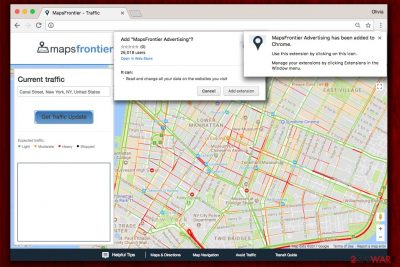
Maps Frontier is a browser extension for Google Chrome and other browsers. It is promoted as an app capable of helping users with directions, traffic information, transit routes, and similar data. Unfortunately, it is also an ad-supported software that fills users' browsers with advertisements and secretly collects their search data. This sponsored content helps developers to increase traffic to less-known websites, earning them money in return. Nevertheless, users are left in-between, as they have to continually deal with banners, offers, deals, coupons, and other pop-ups which may even hinder the content of legitimate websites.
| SUMMARY | |
| Name | Maps Frontier virus |
|---|---|
| Type | Adware |
| Affected OS | Windows, Mac OS X |
| targeted browsers | Google Chrome, Mozilla Firefox, Internet Explorer, Safari, and other popular browsers |
| Main dangers | Exposure to malware-ridden and other dangerous sites |
| Distribution | Software bundling, official web page |
| Symptoms | Intrusive ads in form of pop-ups, deals, banners, offers, coupons, etc. |
| Elimination | You can uninstall it automatically by using anti-malware tools |
| Recovery | System performance can get repaired with tools like FortectIntego that find and fix virus damage or affected system files |
In fact, issues with this add-on begin with its distribution method. Despite the fact that it can be downloaded from the official site, it has also been spread bundled with various free programs. Therefore, it’s easy to download it unknowingly. However, it’s impossible to overlook the browser extension and similar ones once you open Google Chrome, Mozilla Firefox, Internet Explorer, Safari, or another web browser.
So-called Maps Frontier virus is capable of changing some settings on the affected computer and each of the affected web browser in order to display commercial content, for instance:
- Alter Windows registry or create new registry keys;[1]
- Set itself as autorun application and boot with Windows OS;
- Modify browsers’ shortcuts and settings;
- Use virtual layer to display ads, banners, or other types of online ads on visited websites.
These changes are needed in order to generate advertising-based revenue for the Maps Frontier pop-up developers. Unfortunately, they might be trying to reach their goal quite aggressively. Ads related to this PUP might cover the whole browser’s screen, cover needed content, do not have a close (X) button, and follow you on each website you visit.
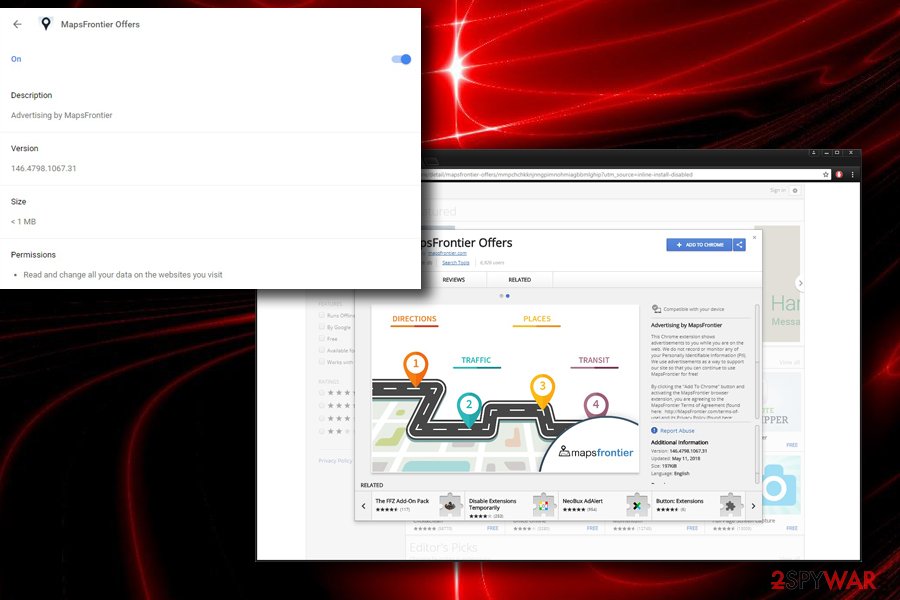
Typically, Maps Frontier adware displays ads presenting shopping offers, discounts, price comparisons, and other deals that “you might be interested in.” Indeed, some of them might look interesting because of data tracking activities[2] which allow the adware to display personalized ads.
However, it’s important to stay away from too-good-to-be-true offers. Usually, they are misleading and created only for getting your click. This is a way for the creators and developers to gain income from ads. Additionally, beware that some of these banners or pop-ups might redirect to dangerous sites where you might install malware or lose personal information.
An increased possibility to encounter cyber threats and significantly decreased browsing experience are not the only reasons to remove Maps Frontier from your computer. Adware is a sneaky software that usually gathers non-personally identifiable information, which sometimes may include personal data.
The problem is, that you can never be sure where this data might end up. Therefore, be wary and do not disclose any personal details on the internet, unless you know for sure that the website is secure.
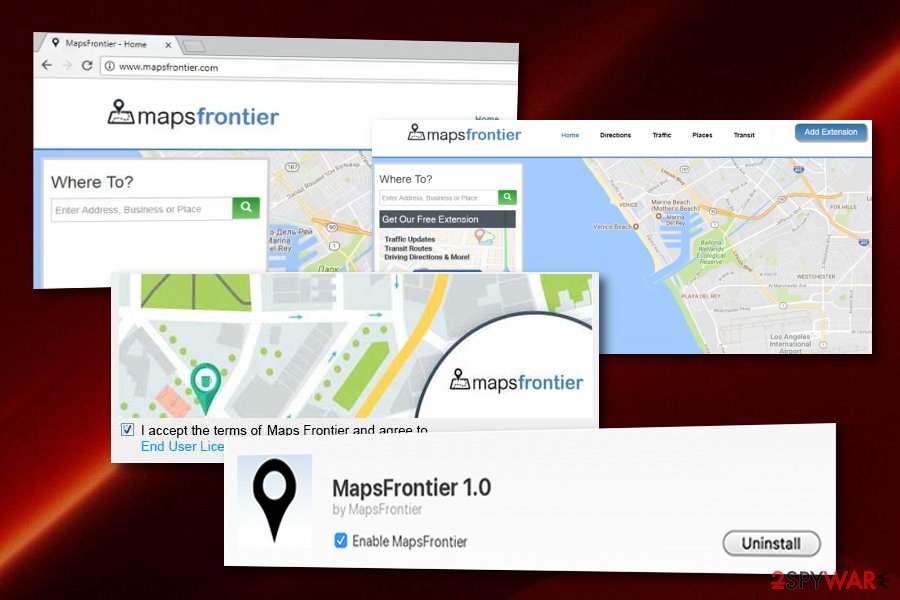
Maps Frontier virus Mac might be capable of gathering informative details that relate to the user's browsing experience, habits, and history. Once this type of information is collected, the developers share it with other parties to collect the income. As you see, adware programs[3] are based only on beneficial purposes are none of the user's needs are fulfilled with this app.
This PUP adware-based program should not remain on your system for long. If you have spotted any unknown changes in the homepages of your Google Chrome, Mozilla Firefox, Internet Explorer, Microsoft Edge, or Safari web browsers, you should take some actions to eliminate the potentially unwanted program immediately.
Maps Frontier issue – data tracking that endangers users
By using tracking cookies,[4] pixels, tags, and similar technologies, the browser extension can collect various non-personally identifiable information, such as visited websites, search queries, clicked ads or links, and other browsing-related activities.
This information allows building your profile and displaying engaging advertisements. Therefore, this ad-supported program communicates with ad networks and then delivers ads to the extension user. In addition, the non-PII is shared with partners, as described in Privacy Policy:
We may share your PII with our parent company and its principals, parent company, employees, consultants, officers, directors, members, agents, subsidiaries, or affiliates (collectively “Related Companies”).
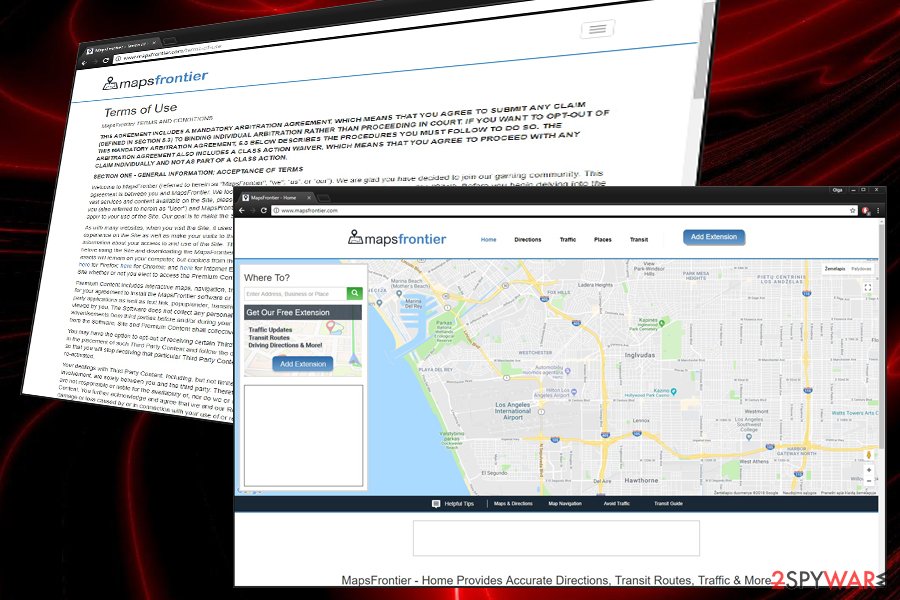
Therefore, during this time, you might find your browser crashing and freezing due to the excessive amount of ads displayed by the extension and third parties.[5] Also, you might start unintentionally visiting high-risk websites which affects your online security. So, you should uninstall Maps Frontier to protect yourself.
For the proper virus removal, we strongly suggest using anti-malware software like SpyHunter 5Combo Cleaner, Malwarebytes. However, you can also get rid of this adware and its related components manually. Our team has prepared a detailed guide at the end of the article.
Software bundles are the main way used to spread PUPs
We have briefly mentioned that the extension is capable of getting into the system unnoticed with the help of free programs. Usually, you are offered to choose between Standard/Default and Custom/Advanced freeware installation mode. If you choose the first one, you give permission to add unwanted software to your computer.
Hence, you have to choose the Custom/Advanced installation option and see what extra items the software installer suggests adding to your computer. All that you need to do then is to deselect these additions and proceed with the installation. It's the only way to avoid unwanted apps and their negative features.
Losvirus.es team[6] recommends choosing reliable file-sharing sources to get your downloads from because attempts to download files or programs from unknown and suspicious-looking sites simply increase the chances of installing potentially unwanted programs.
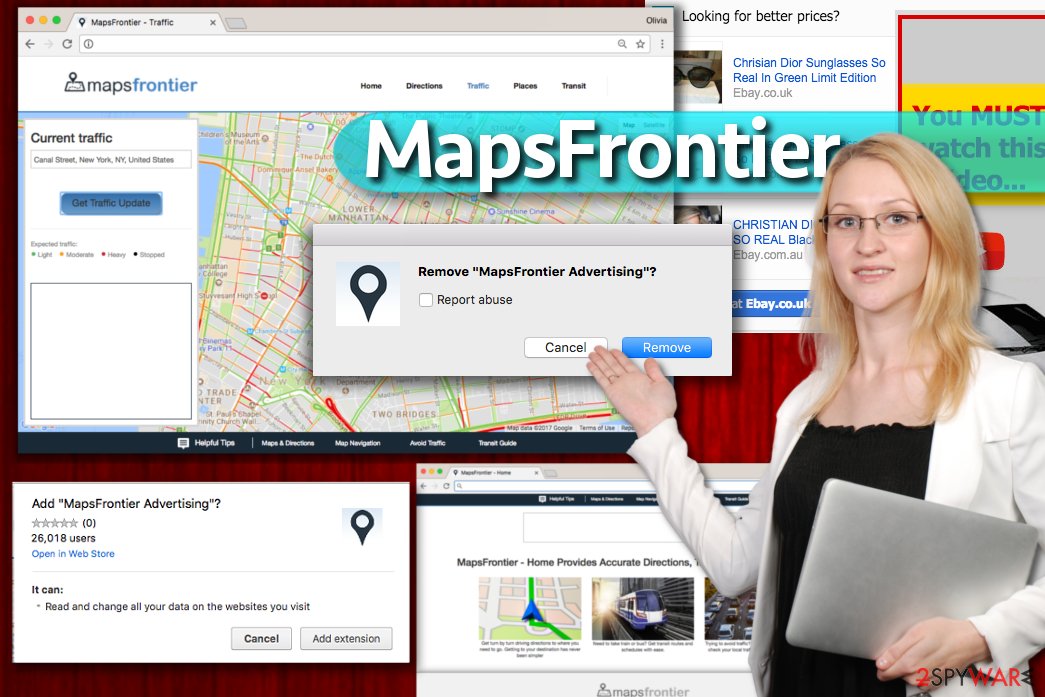
To uninstall Maps Frontier from the system, you need to get rid of its components
To perform the full virus removal on your computer, you need to choose one of two different methods that we find the most effective when dealing with such threats. The first method that we selected for infected users is automatic removal. By cleaning the system with anti-malware software, you will be capable of making sure that all malicious components (not necessarily related to this adware) are gone.
The second option that you can choose is removing this PUP manually. While both methods are effective and the automatic removal option is definitely easier to do, you can also follow the guidelines below in order to remove Maps Frontier completely. The adware may have arrived together with other PUPs or installed questionable entries itself. You have to find and get rid of them all.
Maps Frontier video removal guide
You can remove Maps Frontier by using reputable software but if you are not likely to use only automatical programs, you can give our below-provided video a try. You will be informed and provided with steps on how to get rid of the unwanted application from your computer system. Make sure to follow each action and complete them correctly.
You may remove virus damage with a help of FortectIntego. SpyHunter 5Combo Cleaner and Malwarebytes are recommended to detect potentially unwanted programs and viruses with all their files and registry entries that are related to them.
Getting rid of MapsFrontier virus. Follow these steps
Uninstall from Windows
Instructions for Windows 10/8 machines:
- Enter Control Panel into Windows search box and hit Enter or click on the search result.
- Under Programs, select Uninstall a program.

- From the list, find the entry of the suspicious program.
- Right-click on the application and select Uninstall.
- If User Account Control shows up, click Yes.
- Wait till uninstallation process is complete and click OK.

If you are Windows 7/XP user, proceed with the following instructions:
- Click on Windows Start > Control Panel located on the right pane (if you are Windows XP user, click on Add/Remove Programs).
- In Control Panel, select Programs > Uninstall a program.

- Pick the unwanted application by clicking on it once.
- At the top, click Uninstall/Change.
- In the confirmation prompt, pick Yes.
- Click OK once the removal process is finished.
Delete from macOS
Remove items from Applications folder:
- From the menu bar, select Go > Applications.
- In the Applications folder, look for all related entries.
- Click on the app and drag it to Trash (or right-click and pick Move to Trash)

To fully remove an unwanted app, you need to access Application Support, LaunchAgents, and LaunchDaemons folders and delete relevant files:
- Select Go > Go to Folder.
- Enter /Library/Application Support and click Go or press Enter.
- In the Application Support folder, look for any dubious entries and then delete them.
- Now enter /Library/LaunchAgents and /Library/LaunchDaemons folders the same way and terminate all the related .plist files.

Remove from Microsoft Edge
Delete unwanted extensions from MS Edge:
- Select Menu (three horizontal dots at the top-right of the browser window) and pick Extensions.
- From the list, pick the extension and click on the Gear icon.
- Click on Uninstall at the bottom.

Clear cookies and other browser data:
- Click on the Menu (three horizontal dots at the top-right of the browser window) and select Privacy & security.
- Under Clear browsing data, pick Choose what to clear.
- Select everything (apart from passwords, although you might want to include Media licenses as well, if applicable) and click on Clear.

Restore new tab and homepage settings:
- Click the menu icon and choose Settings.
- Then find On startup section.
- Click Disable if you found any suspicious domain.
Reset MS Edge if the above steps did not work:
- Press on Ctrl + Shift + Esc to open Task Manager.
- Click on More details arrow at the bottom of the window.
- Select Details tab.
- Now scroll down and locate every entry with Microsoft Edge name in it. Right-click on each of them and select End Task to stop MS Edge from running.

If this solution failed to help you, you need to use an advanced Edge reset method. Note that you need to backup your data before proceeding.
- Find the following folder on your computer: C:\\Users\\%username%\\AppData\\Local\\Packages\\Microsoft.MicrosoftEdge_8wekyb3d8bbwe.
- Press Ctrl + A on your keyboard to select all folders.
- Right-click on them and pick Delete

- Now right-click on the Start button and pick Windows PowerShell (Admin).
- When the new window opens, copy and paste the following command, and then press Enter:
Get-AppXPackage -AllUsers -Name Microsoft.MicrosoftEdge | Foreach {Add-AppxPackage -DisableDevelopmentMode -Register “$($_.InstallLocation)\\AppXManifest.xml” -Verbose

Instructions for Chromium-based Edge
Delete extensions from MS Edge (Chromium):
- Open Edge and click select Settings > Extensions.
- Delete unwanted extensions by clicking Remove.

Clear cache and site data:
- Click on Menu and go to Settings.
- Select Privacy, search and services.
- Under Clear browsing data, pick Choose what to clear.
- Under Time range, pick All time.
- Select Clear now.

Reset Chromium-based MS Edge:
- Click on Menu and select Settings.
- On the left side, pick Reset settings.
- Select Restore settings to their default values.
- Confirm with Reset.

Remove from Mozilla Firefox (FF)
Remove dangerous extensions:
- Open Mozilla Firefox browser and click on the Menu (three horizontal lines at the top-right of the window).
- Select Add-ons.
- In here, select unwanted plugin and click Remove.

Reset the homepage:
- Click three horizontal lines at the top right corner to open the menu.
- Choose Options.
- Under Home options, enter your preferred site that will open every time you newly open the Mozilla Firefox.
Clear cookies and site data:
- Click Menu and pick Settings.
- Go to Privacy & Security section.
- Scroll down to locate Cookies and Site Data.
- Click on Clear Data…
- Select Cookies and Site Data, as well as Cached Web Content and press Clear.

Reset Mozilla Firefox
If clearing the browser as explained above did not help, reset Mozilla Firefox:
- Open Mozilla Firefox browser and click the Menu.
- Go to Help and then choose Troubleshooting Information.

- Under Give Firefox a tune up section, click on Refresh Firefox…
- Once the pop-up shows up, confirm the action by pressing on Refresh Firefox.

Remove from Google Chrome
Delete malicious extensions from Google Chrome:
- Open Google Chrome, click on the Menu (three vertical dots at the top-right corner) and select More tools > Extensions.
- In the newly opened window, you will see all the installed extensions. Uninstall all the suspicious plugins that might be related to the unwanted program by clicking Remove.

Clear cache and web data from Chrome:
- Click on Menu and pick Settings.
- Under Privacy and security, select Clear browsing data.
- Select Browsing history, Cookies and other site data, as well as Cached images and files.
- Click Clear data.

Change your homepage:
- Click menu and choose Settings.
- Look for a suspicious site in the On startup section.
- Click on Open a specific or set of pages and click on three dots to find the Remove option.
Reset Google Chrome:
If the previous methods did not help you, reset Google Chrome to eliminate all the unwanted components:
- Click on Menu and select Settings.
- In the Settings, scroll down and click Advanced.
- Scroll down and locate Reset and clean up section.
- Now click Restore settings to their original defaults.
- Confirm with Reset settings.

Delete from Safari
Remove unwanted extensions from Safari:
- Click Safari > Preferences…
- In the new window, pick Extensions.
- Select the unwanted extension and select Uninstall.

Clear cookies and other website data from Safari:
- Click Safari > Clear History…
- From the drop-down menu under Clear, pick all history.
- Confirm with Clear History.

Reset Safari if the above-mentioned steps did not help you:
- Click Safari > Preferences…
- Go to Advanced tab.
- Tick the Show Develop menu in menu bar.
- From the menu bar, click Develop, and then select Empty Caches.

After uninstalling this potentially unwanted program (PUP) and fixing each of your web browsers, we recommend you to scan your PC system with a reputable anti-spyware. This will help you to get rid of MapsFrontier registry traces and will also identify related parasites or possible malware infections on your computer. For that you can use our top-rated malware remover: FortectIntego, SpyHunter 5Combo Cleaner or Malwarebytes.
How to prevent from getting adware
Access your website securely from any location
When you work on the domain, site, blog, or different project that requires constant management, content creation, or coding, you may need to connect to the server and content management service more often. The best solution for creating a tighter network could be a dedicated/fixed IP address.
If you make your IP address static and set to your device, you can connect to the CMS from any location and do not create any additional issues for the server or network manager that needs to monitor connections and activities. VPN software providers like Private Internet Access can help you with such settings and offer the option to control the online reputation and manage projects easily from any part of the world.
Recover files after data-affecting malware attacks
While much of the data can be accidentally deleted due to various reasons, malware is one of the main culprits that can cause loss of pictures, documents, videos, and other important files. More serious malware infections lead to significant data loss when your documents, system files, and images get encrypted. In particular, ransomware is is a type of malware that focuses on such functions, so your files become useless without an ability to access them.
Even though there is little to no possibility to recover after file-locking threats, some applications have features for data recovery in the system. In some cases, Data Recovery Pro can also help to recover at least some portion of your data after data-locking virus infection or general cyber infection.
- ^ Tim Fisher. What Is a Registry Key?. Lifewire. Tech untangled.
- ^ Chris Hoffman. Browser Extensions Are a Privacy Nightmare: Stop Using So Many of Them. How-To Geek. For Geeks, By Geeks.
- ^ Adware. Malwarebytes. Tech information.
- ^ Tracking Cookies: What They Are, and How They Threaten Your Privacy. Tom's Guide. Tech Product Reviews, Top Picks and How To.
- ^ Third Party. Business Dictionary. Definitions.
- ^ LosVirus. LosVirus. Malware, Spyware Removal Guidelines.























